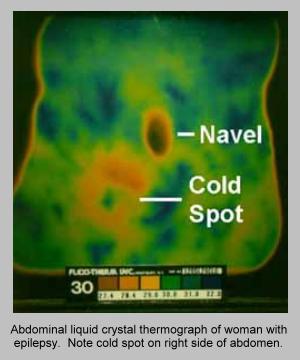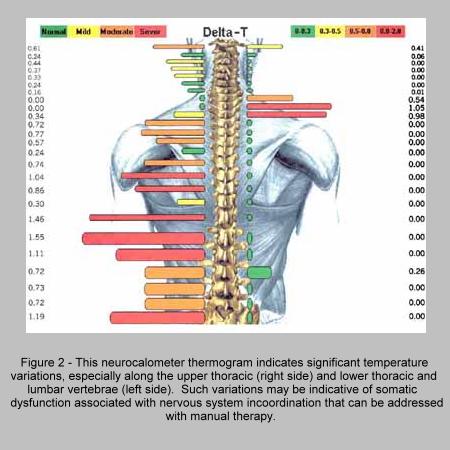
 Thermography involves the measurement of temperature displayed in a visual
format. This noninvasive assessment modality can provide helpful
information about physiological dysfunction. For several years Meridian
Institute has been exploring various medical thermographic techniques,
including liquid crystal thermography, infrared neurocalometry, and computerized
regulatory thermography.
Thermography involves the measurement of temperature displayed in a visual
format. This noninvasive assessment modality can provide helpful
information about physiological dysfunction. For several years Meridian
Institute has been exploring various medical thermographic techniques,
including liquid crystal thermography, infrared neurocalometry, and computerized
regulatory thermography.
Liquid-crystal thermography (LCT) employs a range of interchangeable detector "screens" that are impregnated with cholesteric methylester derivatives that change color as a function of their temperature. An LCT screen is placed on the body for a few seconds before a Polaroid camera takes a color snapshot of the screen. Temperature variations show up as color patterns in a range of about 10 degrees Fahrenheit. Because LCT is simple and fast, it has been particularly helpful in measuring abdominal temperature anomalies in epilepsy. Edgar Cayce insisted that in all cases of a true epileptic nature that a cold spot would be found on the right side of the abdomen between the liver and caecum. According to Cayce, the cold spot is associated with adhesions in the lacteal ducts (lymph vessels) that permeate this area of the small intestine. We have previously reviewed the concept of abdominal epilepsy as it relates to the enteric nervous system (see The Abdominal Brain and Enteric Nervous System, Vol 4, No 4; July, 2000). Our preliminary research involving seven individuals with epilepsy is supportive of Cayce's hypothesis with respect to cooler temperatures on the right side vs. left side of the abdomen in epilepsy. In some patients, the cool spot is extremely distinctive (Figure 1). In others, it is relatively cooler when compared to areas of temperature variation across the abdomen. One of the major disadvantages of LCT is that it produces visual (analog) data that is difficult to quantify for standard statistical analysis. At this point, we intend to continue collecting data from epilepsy patients. We are interested in working with neurologists who have access to many epilepsy patients and are willing to participate in this project. Eventually, we would like to obtain a more sophisticated (and expensive) infrared camera that can provide quantitative data without contacting the skin.
Our research of IN has focused on two areas: 1) evaluation of somatic dysfunction (such as spinal subluxation) and 2) effects of manual therapy (spinal massage and manipulation). We are still in the early stages of research in both areas. We are impressed with the computer printouts provided by the IN system as it clearly distinguishes anomalous areas (Figure 2). Also, the data can be downloaded to spreadsheet for statistical analysis. Computerized Regulatory Thermography (CRT) measures the temperatures of various parts of the body associated with organ and visceral function. Two sets of data are collected. The first set of measurements assess the skin temperature of the body as adapted to normal room temperature. A second set of measurements assess the body's reaction to a controlled cooling of the environment. The comparison of these data sets provides information about the organism's ability to self-regulate. In this way, we can gain insight into focal areas of disease. At this point, CRT has been used primarily in the
HRRC Assessment Center. As we collect more data, we intend to compare
thermographic data and interpretive indexes utilized by the CRT program
to other assessment techniques, especially the other thermographic modalities
described above.
David McMillin, MA recently presented a paper titled "An Integrative Model of Migraine Based on Intestinal Etiology" at the 5th Annual Cayce Health Professionals Symposium in Virginia Beach. McMillin, a researcher with Meridian Institute, discussed the concept of abdominal migraine as described in the Edgar Cayce readings. In one reading that is typical of Cayce's views on migraine, he observed that "... conditions to which the body becomes allergic in the digestive system should be looked for - that deal with all migraine headaches. So, this information might be used universally as to the sources of such, if it would be accepted." Thus, according to Cayce, the general pattern of pathology in idiopathic migraine involves an allergic irritation in the intestines which is transmitted to the trigeminal (fifth cranial nerve) and also triggers an imbalance of circulation to the head. Cayce's model of idiopathic migraine takes into consideration both the nerve and vascular aspects of migraine. The paper documents the historic and modern medical literature that supports the concepts of abdominal migraine, dietary migraine, and somatic dysfunction in migraine. Natural therapies intended to address the underlying intestinal dysfunction are described. The paper may be found on the Meridian Institute website at: We will cover the full proceedings of the symposium
in our next newsletter.
Edgar Cayce typically recommended animated or carbon ash taken internally to increase oxygenation of the blood for persons with cancer. After ingestion of the ash, ultra-violet light was shone on the body to enhance the oxygenation process. A report by Dr. Barry Wenig given at the annual meeting of the American Society for Clinical Oncologists in New Orleans contains remarkable parallels to Cayce's approach. In the new photodynamic therapy advocated by Wenig, a cream containing the drug Foscan temoporfin is injected around a cancerous tumor. After four days a light is beamed onto it. When activated by the light, the cream releases oxygen that destroys the cancerous cells without damaging healthy tissue. In a trial, 64 patients terminally ill with skin cancer were treated with the therapy. The patients were classed as incurable and the only other option was to refer them to hospices. An independent panel of experts judged that 58% of patients had extended their survival times; 25% had achieved a complete or partial reduction of the tumor; in 16% the tumor had been completely eliminated. The therapy is not yet available for use in the USA or Europe. A two-year trial is currently underway in Leeds, UK. Acknowledgment: Thanks to Wayne Emley for calling
our attention to this research. The original article by Helen Rumbelow
appeared in the London Times on May 30, 2000.
|

 Infrared neurocalometry (IN) makes use of infrared technology for the measurement
of temperature variations along the spine. Edgar Cayce specifically
recommended neurocalometry as an assessment technique in reading 480-44
observing that "... there has been perfected or used in the chiropractic
association a thermometer, or a gadget that run along the spine shows WHEN
they coordinate one with another, see?"
Infrared neurocalometry (IN) makes use of infrared technology for the measurement
of temperature variations along the spine. Edgar Cayce specifically
recommended neurocalometry as an assessment technique in reading 480-44
observing that "... there has been perfected or used in the chiropractic
association a thermometer, or a gadget that run along the spine shows WHEN
they coordinate one with another, see?"